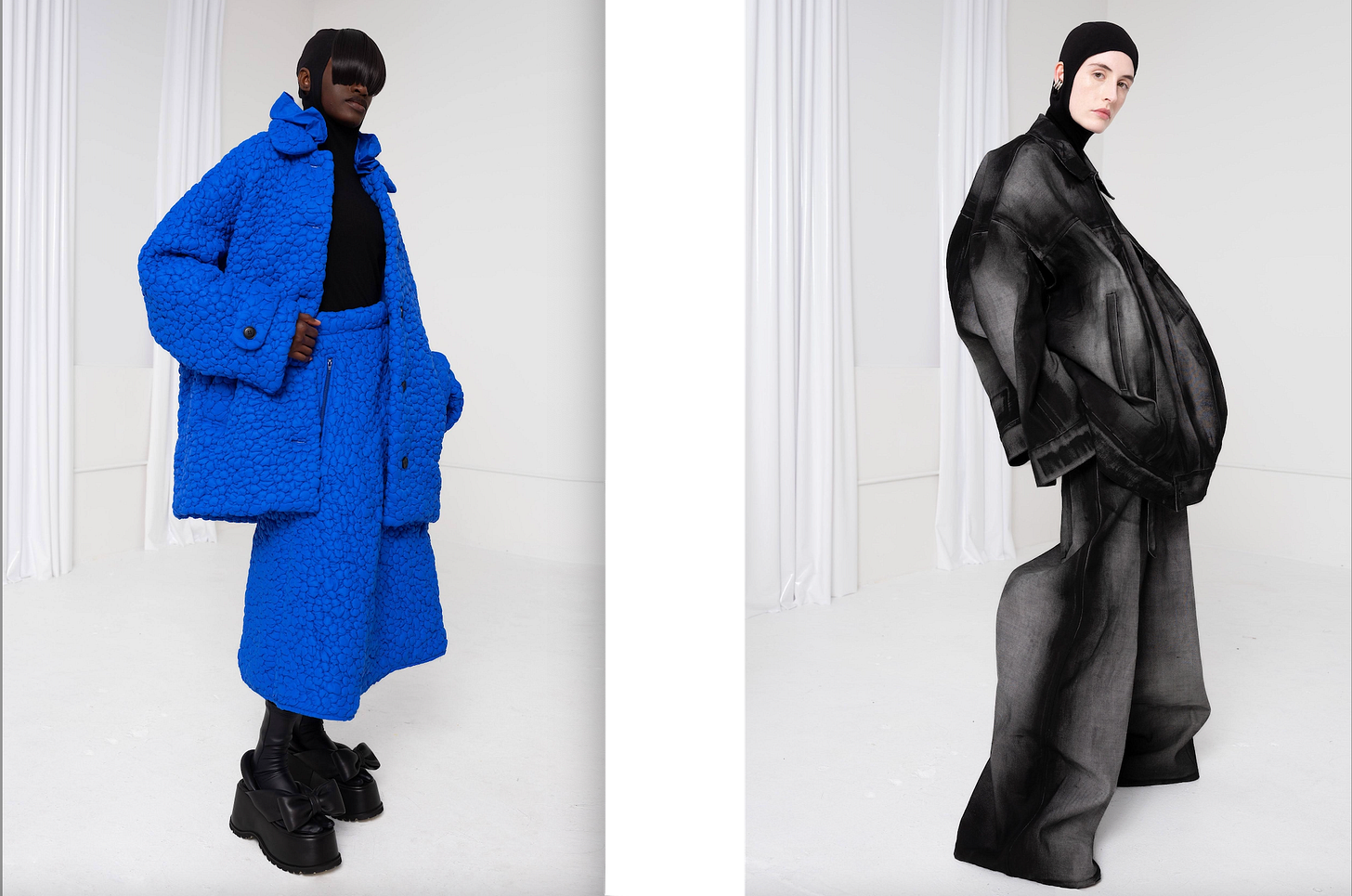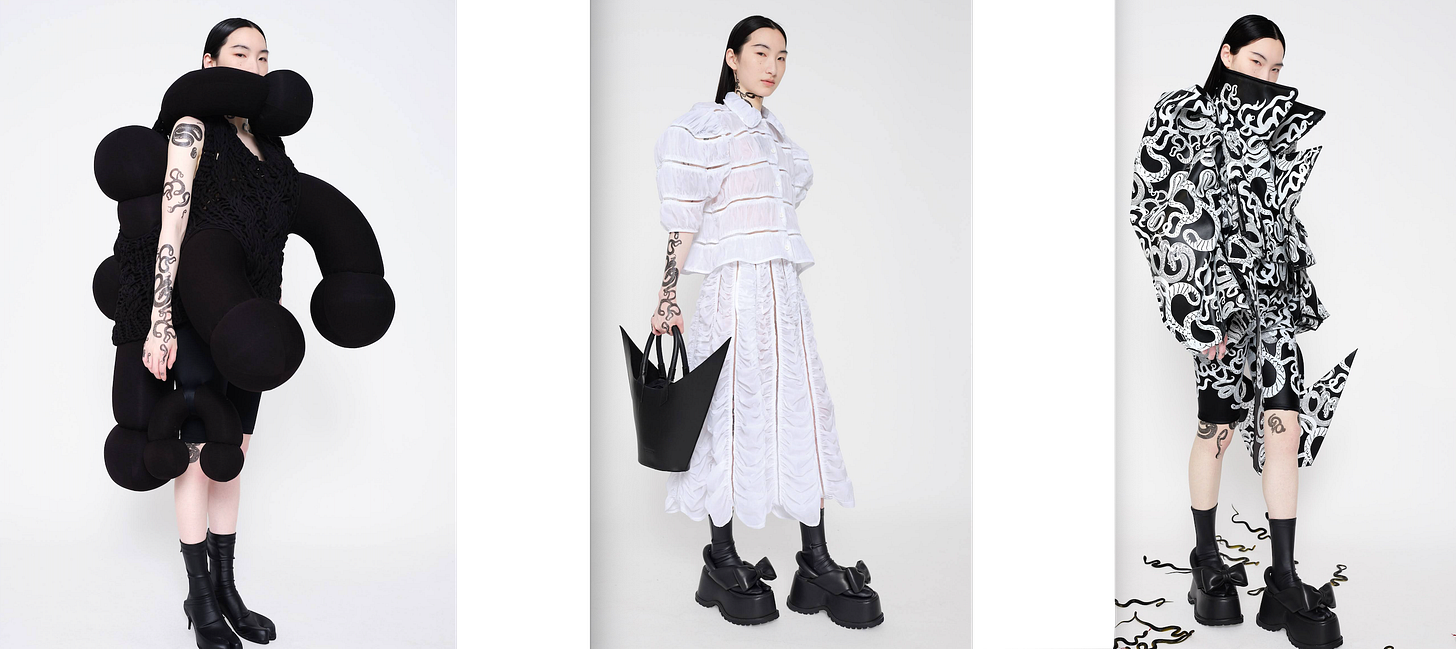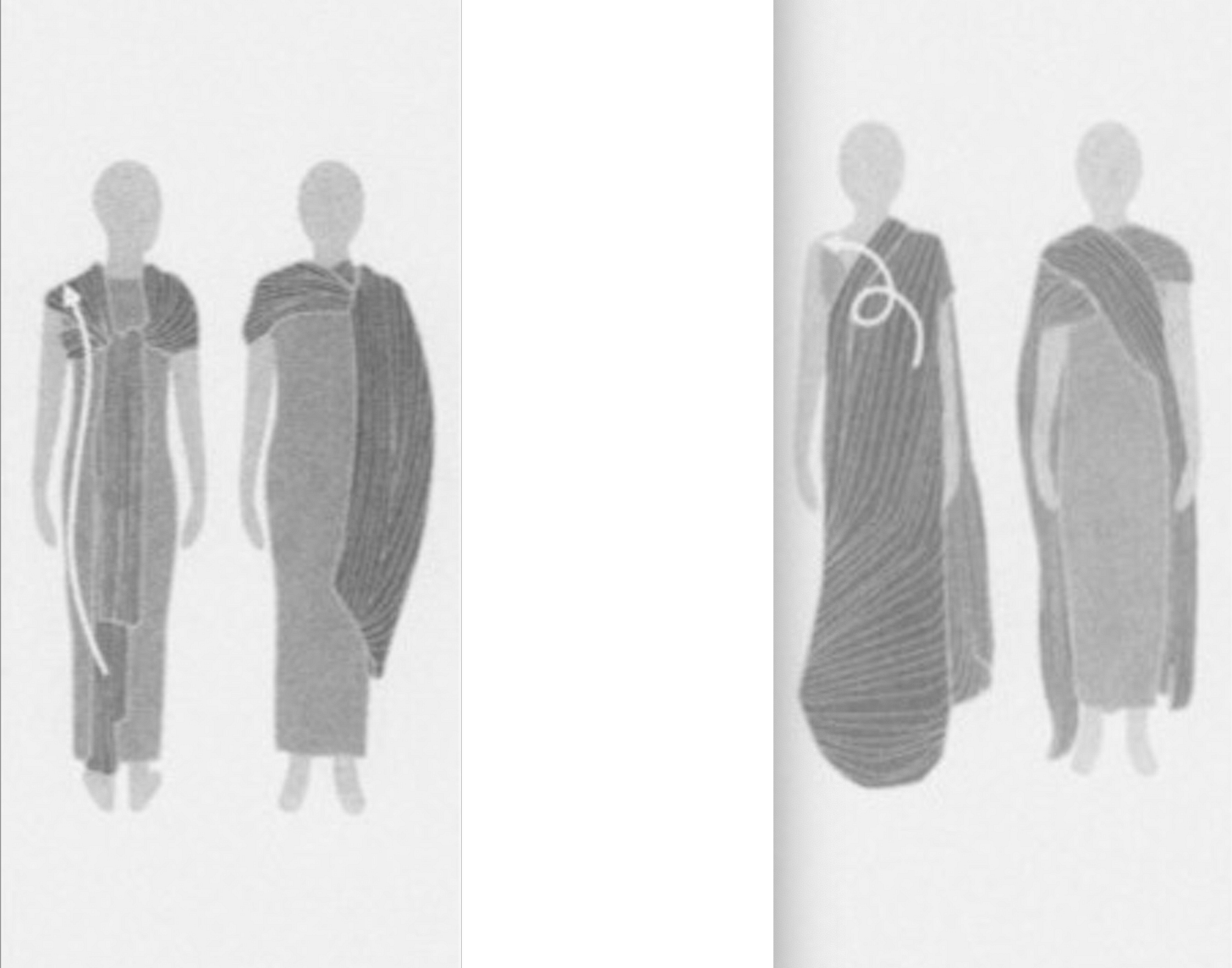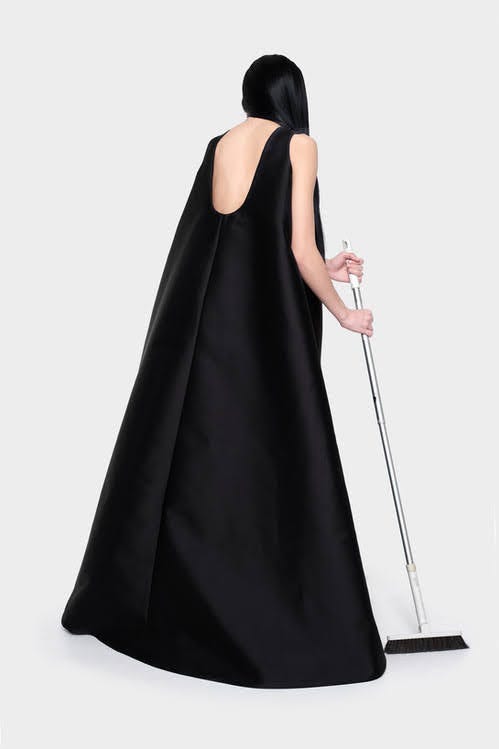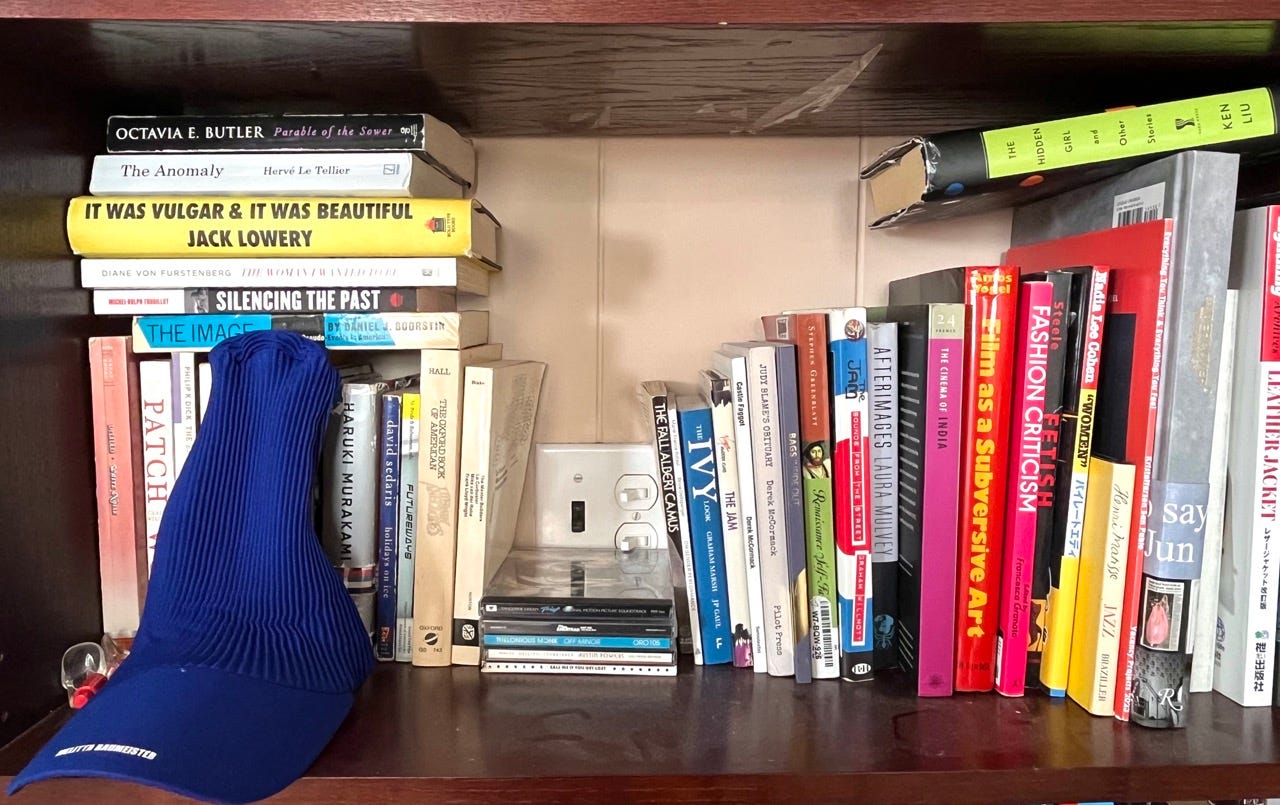The first five people in line at Melitta Baumeister’s sample sale looked like the setup for a bad joke. A fashion student in Salomons, a pair of older fashion academics in Donna Karan sleeping bag coats and Balenciaga accouterment, two Hasidic women, and at the very front, me: sweaty ex-hypebeast, in stained Kapital denim, reading my book standing up.
The fashion student scrolls while the academics converse quietly. The Hasids comb through the rolls of free pleated fabrics, synthetics, and bundles of faux teddy shearling while wondering aloud why we cannot enter early.
Each of us is here in one sense or another for Melitta Baumeister, local New York designer by way of Germany, and distortionist of body and material. Her work invokes the pleats and stretch of Issey Miyake, the bulbousness, angular cuts, and polyester of Comme des Garcons, and the cartoonish oversized cuts of the early 2020s. Baumeister’s colors skew dayglo greens, Yves Klein blues, or washed monochrome. A hoodie may have ear cutouts and stretch to the knees, a bomber jacket may include extra armholes to transform it into a cape, and a boot may feature two heels or a leather bow. Her signature accessories are a baseball cap with a tall pleated column on top and a leather banana keychain.
I first discovered Baumeister at Dover Street Market across from Jacquemeus, where her weird pleated creations bobbed like sculptures. Baumeister won the CFDA’s fashion fund in 2023 and her work began getting attention at larger department stores and stocklists, introducing crowds of older Miyake collectors, flashy oddballs of the American aristocratic class, and modern avant dandies.
When allowed in I was afforded a gaze into everyone’s try-on racks. The student found a vanta pencil skirt I could imagine with a cute button-up and pumps at a Chelsea gallery. The professors opted for an oversized denim jacket that flared out at the back, coated in an acid wash. Hit superstar Fabulous opted for a similar jacket. The hasids had an entire rack of black cropped jackets and trousers in different pleats and synthetics.
Suddenly it hit me: if Issey Miyake were having a pleats please sample sale, these people would likely also be in line. These garments attracted a similar customer, curiosity, and attention that spanned culture and age. Perhaps it is no coincidence that debates over the canonization of Miyake pleats have raged in fashion spaces. Are Miyake’s for the old? Are they boring with tabi shoes? When is the uniqueness of a pleat most activated, if it can be at all?
Regardless, it is clear that the polyester pleat has become a branded signifier for Miyake.
In 2003, Giuliana Bruno wrote in “Pleats of Matter, Folds of the Soul“ on the connection between Deleuze’s conception of the fold as “a corporeal architecture that houses the materiality of spirit… the very "fashioning" of spirit” to Miyake’s pleats as physicalized unifiers of mind/affect and body. Much of this unity has to do with the pleats as a “home” that in entering “comes alive. It becomes different garments. It reshapes itself.” Bruno sees the pleat as giving “the inhabitant an active role in fashioning it” - adaptation to the body allows the pleat to become a naturalist mirror of the soul.
Bruno mainly dealt with Miyake’s APOC line, but nowadays there are a multitude of Miyake sub labels that center on the pleat. Mainline Miyake is almost always pleated these days, not to mention Pleats Please, Homme Plisse, and older labels like Issey Miyake ME. In this crop, we’ve seen pleats in every color and of every garment. These garment “homes“ have been rainforests, tapestries, oceans, denim, and great works of art. Each of these contexts becomes a new mode of complicating and resituating the pleated garment’s translation of mind to body.
Baumeister’s contribution and inversion of the pleat as a pure diviner of undiluted affect is the acknowledgment of pattern, texture, and the highly synthetic as an inherently strange translation. Bruno claims Miyake’s pleat “tells you who you are and how you feel. Even if you do not know it,” but rarely does Miyake force rigid shapes and distortions on the wearer, nor reveal his ways of maintaining shape in the way Baumeister does. Her “houses“ are more fixed in their meanings and contrast in sharper ways to body and naturalism. They become interrogations of the pleat’s functionality, tests of whimsy and contrast. What if your pants bloomed out at the ankles? What if your shoulders were spheres? What if your dress fell in the same right angle all the time?
Whereas Miyake may celebrate a naturalism to androgeny, a personal (and therefore potentially transgressive) expression of gendered & degendered bodies, Baumeister’s work pokes at the boundaries themselves. Baumeister’s cutouts and sheer blouses reveal bodies amidst transformation via garments, restrained by tightness yet free in movement. They offer the same physical freedom as a Miyake pleat, but with more direct conceptual challenges.
My favorite part of this aspect of Baumeister’s garments is the lightness with which she gestures to deconstruction. There is elegance to the pleat, melodrama, and sex to the binding and revealing of a body. For Baumeister, the reveal is through a smiley face tee shirt and humorous oversize, the tightness is in whimsical wrongness, the elegance in school highlighter neon. Her work gives hope to humanity within the industrial and synthetic.
Baumeister similarly questions the pleat as a signifier. When does the haute grow tedious, if not ridiculous? How do you reignite that which is normalized with passionate strangeness? My favorite Baumeister garments explore this: the tabi boot that features a bubbled camel toe, a simple pleated dress with bobbling spheres at the shoulders, a cargo dress a la Junya SS03, here almost translucent in pristine white. How do we move on from canon, while utilizing and experimenting on what makes these garments so powerful? What happens when we turn the affective possibilities of beautiful works inside out?
Compare Baumeister’s play on form-as-signifier with the pleated set by The Row, priced at about seven thousand dollars and virtually identical to a Miyake set at a seventh of the price (and even less if purchased used). The swapping of labels to play with fashion canon is far more common, and a ploy that often celebrates the shallow of heart and deep of pocket. Baumeister’s questions are more considered, and so her crowds are disparate and discerning.
This is why Baumeister’s clothes have such enticing appeal between the conservative black Hasidic dress code accommodating luxurious label, movement, and sensible look, and that of a queer Bushwick denizen looking to peacock and affirm and signal a more complex sense of gender identity. Baumeister’s pieces stretch to serve both.
I leave with a cropped black shirt with a high collar in a thin, shiny black neon. It hugs my shoulders tightly and pairs well with my thicker denim and oversized blazers. It makes me feel as if I am hiding a nylon secret, an imperceptible oddity, an invisible lightness.
Because I check out first I am also given one of Baumeister’s hats, the same the designer wears as her uniform. The back of the cap is adjustable to allow for a variety of heads (and hair), and I stretch it all the way so that it sits loosely. I am in the club. I am transformed into a Dr. Seus illustration of luxury streetwear, a sore thumb in rich blueberry, a bizarre assimilation of New York dress. I am marked ridiculous in eloquent terms. What more can I ask for?





